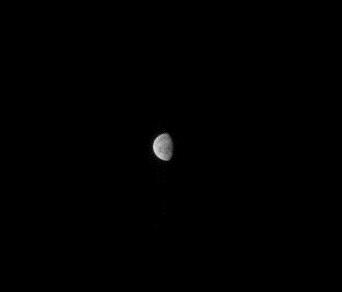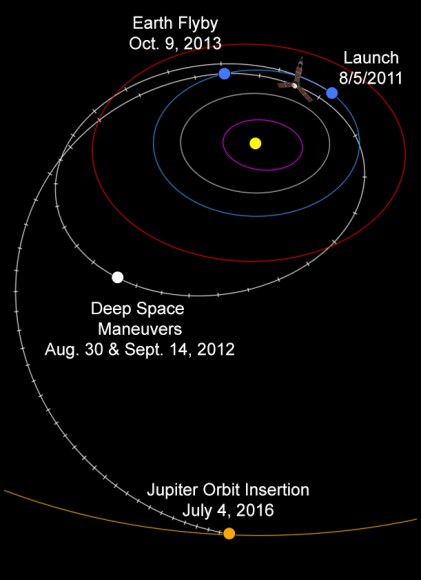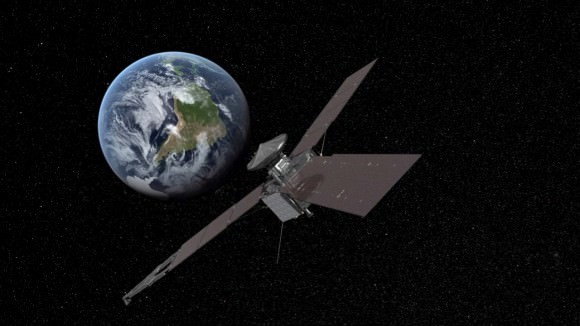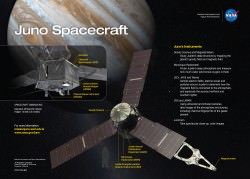Developing story – NASA’s Juno-bound Jupiter orbiter successfully blazed past Earth this afternoon (Oct. 9) and gained its huge and critical gravity assisted speed boost that’s absolutely essential to reach the Jovian system in 2016.
However, Juno’s project manager Rick Nybakken told me moments ago that the Juno spacecraft unexpectedly entered ‘safe mode’ during the fly by maneuver and the mission teams are assessing the situation.
But the very good news is “Juno is power positive at this time. And we have full command ability,” said Nybakken in an exclusive phone interview with me.
“After Juno passed the period of Earth flyby closest approach at 12:21 PM PST [3:21 PM EDT] and we established communications 25 minutes later, we were in safe mode,” Nybakken told me. Nybakken is the Juno mission project manager at NASA’s Jet Propulsion Lab in Pasadena, CA.
Furthermore, the Earth flyby did place the $1.1 Billion Juno spacecraft exactly on course for Jupiter as intended.
“We are on our way to Jupiter as planned!”
“None of this affected our trajectory or the gravity assist maneuver – which is what the Earth flyby is.”
Juno’s closest approach was over South Africa at about 500 kilometers (350 miles).
“Juno hit the target corridor within 2 km of the aim point,” Nybakken elaborated to Universe Today.
Juno needs the 16,330 mph velocity boost from the Earth swingby because the Atlas V launcher was not powerful enough to hurtle the 8000 pound (3267 kg) craft fast enough on a direct path to Jupiter.
And the team is in full radio contact with the probe. Safe mode is a designated protective state.
“Prior to the eclipse, which was a few minutes earlier than closest approach, the spacecraft was ‘nominal’. When we came out of the eclipse Juno was in safe mode,” Nybakken stated.
“We are going through safe mode diagnostics steps right now.”
“We have established full uplink and downlink. And we have full command ability of the spacecraft.”

Speed boosting slingshots have been used on numerous planetary missions in the past
The spacecraft’s power situation and health is as good as can be expected.
“Juno is power positive at this time and sun pointed and stable. So we are very pleased about that,” Nybakken explained.
I asked if Juno had ever entered ‘safe mode’ before?
“We have never been in safe mode before. We are in a safe, stable state.”
“We are investigating this,” said Nybakken.

Today’s (Oct. 9) Earth flyby is the only time the spacecraft experiences an eclipse period during Juno’s entire five year and 1.7 Billion mile (2.8 Billion km) trek to Jupiter, the largest planet in our solar system.
When it finally arrives at Jupiter on July 4, 2016, Juno will become the first polar orbiting spacecraft at the gas giant.
NASA’s Juno spacecraft blasted off atop an Atlas V rocket two years ago from Cape Canaveral Air Force Station, FL, on Aug. 5, 2011 on a journey to discover the genesis of Jupiter hidden deep inside the planet’s interior.

I had an inkling that something might be amiss this afternoon when no images of Earth appeared on the Juno mission website.
So I asked the status.
“We don’t know yet if any images of Earth were collected. We hope to know soon.”
Juno flew past the Moon before the gravity assist slingshot with Earth. And it did manage to successfully capture several lunar images. See the images herein.
Read more about Juno in my flyby preview story – here.
Note: Due to the continuing chaos resulting from the US government partial shutdown caused by gridlocked politico’s in Washington DC, NASA public affairs remains shut down and is issuing no official announcements on virtually anything related to NASA! This pertains to Juno’s flyby, LADEE’s lunar arrival on Oct. 6, MAVEN’s upcoming launch in November, Cygnus at the ISS, and more!
Stay tuned here for continuing Juno, LADEE, MAVEN and more up-to-date NASA news.




